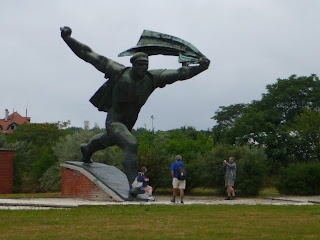At the gates of the park the visitor is greeted by Stalin's boots. The crowd of people revolting in 1956 pulled down the statue of the much hated state leader and commander-in-chief. The crowd toppled the 8 meter statue and broke it to pieces. The boots however remained on the pedestal until the revolution was put down. The pair of boots displayed on the grandstand at Memento Park are a authentic replica of the original and they represent the revolution of 1956 in Hungary.
I have a very strong memory of this gigantic statue of a Russian sailor but my memory is faulty. I must have seen photos of it as it was created after my life in Hungary.
This statue representing Hungarian-Russian friendship which had formerly stood on Gellert Hill is rightly in my portfolio of memories. Together with the one below
the 6 metre tall statue of the gimlet eyed Soviet soldier also once stood on top of Gellert Hill in central Budapest, well seen by everyone from every direction.
In a lighter vein, Andrew and I are sampling the cakes at Russwurm, which some say have the best cakes in the city. We did not dress alike on purpose by the way - it just happened that we are both in yellow.
This wonderful fountain with Gillian sitting at the foot is up at the Royal Palace in Buda. It is the most realistic depiction of hunting dogs with the one appearing to be lapping up the flowing water of the fountain. As both the Bennetts and we are dog lovers we had to capture this fountain. Please click on it to enlarge it and enjoy these dogs. I think you will agree that they are much nicer than the communist inspired statues.

















































